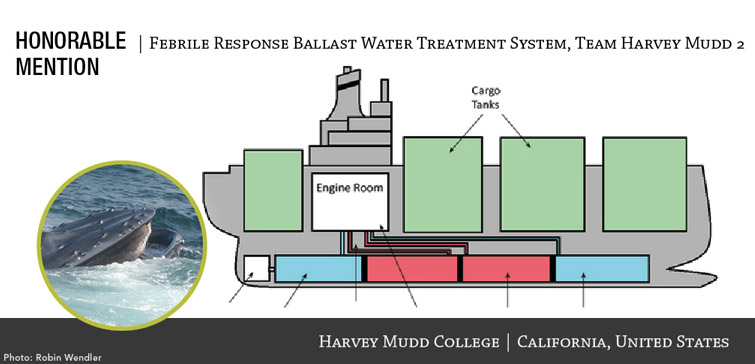Students Excel in Biomimicry Challenge
July 29, 2014
Large-scale, complex human problems call for inspired solutions, like ones that require student teams to use nature’s own resources to create a sustainable and innovative design.
The Harvey Mudd College team of Travis Beckman ’15 (engineering), Emma Frederick ’14 (engineering), Jirka Hladiš ’15 (engineering) and Alexander Lee ’14 (mathematical and computational biology) accepted the international Biomimicry Student Design Challenge and looked to nature to help solve a design issue affecting transportation, the theme for this year’s event. Their project, “The Febrile Response Ballast Water Treatment System,” earned an Honorable Mention (video).
Industrial seagoing vessels continually take in and slough off large amounts of ballast water in order to maintain stability and buoyancy. In the process, these ships introduce potentially harmful new organisms—both visible and microscopic—into marine ecosystems. The team sought a way to filter and treat the water that would minimize the environmental impact of ballast water discharge and better preserve the waning biodiversity of Earth’s oceans.
Their solution proposed a biomimetic ballast water heat-treatment process that prevents the introduction of ballast-borne invasive species into unfamiliar ecosystems. The system takes its design inspiration from whales and sharks and includes a baleen-inspired filter for easy self-cleaning, expandable ballast tanks to separate the treated and untreated water, sharkskin-inspired nonstick piping and a heat exchange system inspired by a gray whale tongue.
“Filter-feeding whale species utilize some of the best filtering technology created in order to sift through millions of krill when feeding,” said Beckman. “We designed a filtering system using baleen-shaped filaments aimed at removing invasive species from the water before it entered the ship’s ballast tanks.”
The team found even more to implement from the whale’s biological design. “The gray whale utilizes countercurrent exchange between the capillaries, veins and tissues in its tongue in order to provide itself with oxygen as well as heat, allowing it to regulate its body temperature,” said Beckman. “We created a similar system with excess heat from the ship’s engines. The system runs incoming water through a pipe surrounded by heated water from the ship’s exhaust heat, killing any small invasive organisms that made it past the baleen filter.”
To ensure no buildup occurred anywhere in the system, the piping was designed with riblets that mimic those of sharkskin, which reduce fluid drag in turbulent flow. The riblets also serve to physically prevent organisms from collecting inside the piping.
Sustainability played a major role in the success of the Harvey Mudd proposal. Contrary to some current solutions to ballast water treatment, the team’s method avoids use of harmful chemicals and supports Life’s Principles of biomimicry—design lessons from nature that stress the interconnectivity and complexity of life on Earth.
The Challenge is open to any student worldwide enrolled in a certificate or degree program. Because most students have not been trained in biomimicry, the cross-disciplinary contest is conducted as a self-directed learning opportunity—something at which Mudders excel.
“It was a great way to learn about a design approach that isn’t normally part of our curriculum,” said Hladiš. “Since biomimetic design is an inherently interdisciplinary undertaking, it fits in perfectly with the overall Harvey Mudd ethos.”
The College fielded an additional team in this year’s contest: Frances Su, Sami Koo, Courtney Keeler and Emma Bodell—all members of Harvey Mudd’s historic 2014 female-majority engineering class. Challenged with reducing helicopter noise pollution through manipulation of blade aerodynamics, the team developed a design based on owl feathers.
Engineering professor and department chair Elizabeth Orwin ’95, who served as faculty advisor to both teams, made particular note of their motivation, pointing out that the students were inspired by the chance to make a difference.
“It’s really about using what nature has created to inspire our own technologies,” said Orwin. “The intricate designs found within nature are what got me so interested in bioengineering in the first place.”
More than 100 student teams submitted nature-inspired transportation concepts during the Biomimicry Challenge. Tying for first place were McGill University, Canada (“Air Ballast Biomimetic Cargo Ship,” a design inspired by fish swim bladders) and Universidad Autónoma de Yucatán, Mexico (“Mocan,” a novel human-powered vehicle design for carrying cargo inspired by millipede and snake motion). Third place went to a team from University of California, Long Beach (“Vibrisee,” an illuminated safety system for bicyclists inspired by whiskers and bioluminescent aquatic organisms).
